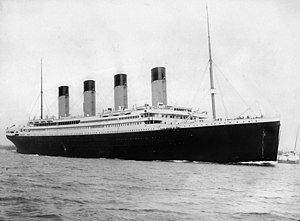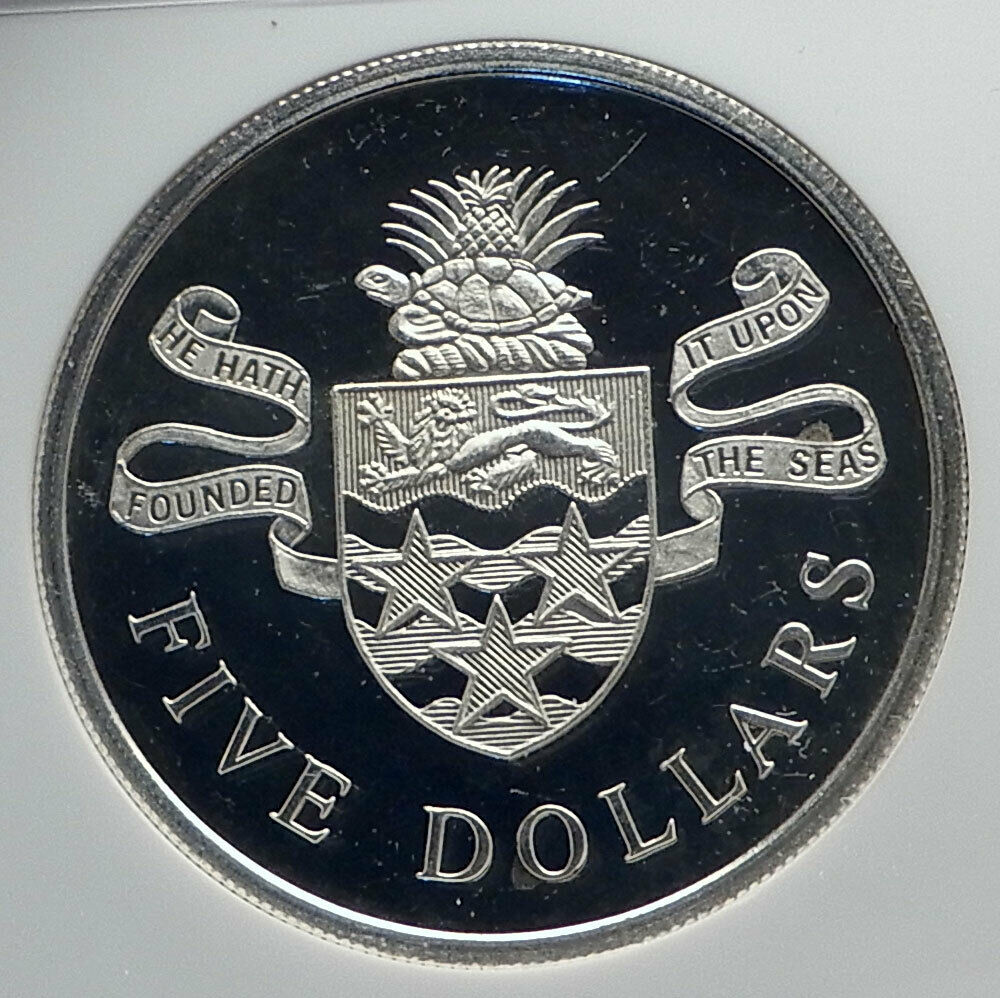|
Turks & Caicos Islands
R.M.S. Titanic
1998 Proof Silver 20 Crowns 38.9mm (31.20 grams) 0.999 Silver (1.00 oz. ASW)
Reference: KM# 240, Schön# 234 | Engraver: Luigi Badia
ELIZABETH II – TURKS AND CAICOS ISLANDS 1998 20 CROWNS, Elizabeth II, crowned head right.
R.M.S. TITANIC, Titanic steaming right (full ship).
You are bidding on the exact item pictured, provided with a Certificate of Authenticity and Lifetime Guarantee of Authenticity.
 RMS Titanic was a British passenger liner, operated by the White Star Line, which sank in the North Atlantic Ocean on 15 April 1912 after striking an iceberg during her maiden voyage from Southampton, UK, to New York City. Of the estimated 2,224 passengers and crew aboard, more than 1,500 died, which made the sinking one of the deadliest for a single ship up to that time. It remains to this day the deadliest peacetime sinking of a superliner or cruise ship. The disaster drew much public attention, provided foundational material for the disaster film genre, and has inspired many artistic works. RMS Titanic was a British passenger liner, operated by the White Star Line, which sank in the North Atlantic Ocean on 15 April 1912 after striking an iceberg during her maiden voyage from Southampton, UK, to New York City. Of the estimated 2,224 passengers and crew aboard, more than 1,500 died, which made the sinking one of the deadliest for a single ship up to that time. It remains to this day the deadliest peacetime sinking of a superliner or cruise ship. The disaster drew much public attention, provided foundational material for the disaster film genre, and has inspired many artistic works.
RMS Titanic was the largest ship afloat at the time she entered service and the second of three Olympic-class ocean liners operated by the White Star Line. She was built by the Harland and Wolff shipyard in Belfast. Thomas Andrews, who was the chief naval architect of the shipyard at that time, died in the disaster.
Titanic was under the command of Captain Edward Smith, who went down with the ship. The ocean liner carried some of the wealthiest people in the world, as well as hundreds of emigrants from Great Britain and Ireland, Scandinavia and elsewhere throughout Europe, who were seeking a new life in the United States and Canada.
The first-class accommodation was designed to be the pinnacle of comfort and luxury, with a gymnasium, swimming pool, libraries, high-class restaurants, and opulent cabins. A high-powered radiotelegraph transmitter was available for sending passenger “marconigrams” and for the ship’s operational use. The Titanic had advanced safety features, such as watertight compartments and remotely activated watertight doors.
The ship was equipped with 16 lifeboat davits, each capable of lowering three lifeboats, for a total of 48 boats; the Titanic carried only 20 lifeboats, four of which were collapsible and proved hard to launch while the ship was sinking. Together, the 20 lifeboats were capable of holding 1,178 people—which was only about half the number of passengers on board, and only one-third of the number of passengers that the ship could have carried at full capacity (this was consistent with the maritime safety regulations of the era). In addition, when the ship sank, many of the lifeboats that had been lowered were only about half full.
 The Turks and Caicos Islands, or TCI for short, are a British Overseas Territory consisting of the larger Caicos Islands and smaller Turks Islands, two groups of tropical islands in the Lucayan Archipelago of the Atlantic Ocean and northern West Indies. They are known primarily for tourism and as an offshore financial centre. The resident population is 31,458 as of 2012 of whom 23,769 live on Providenciales in the Caicos Islands. The Turks and Caicos Islands, or TCI for short, are a British Overseas Territory consisting of the larger Caicos Islands and smaller Turks Islands, two groups of tropical islands in the Lucayan Archipelago of the Atlantic Ocean and northern West Indies. They are known primarily for tourism and as an offshore financial centre. The resident population is 31,458 as of 2012 of whom 23,769 live on Providenciales in the Caicos Islands.
 The Turks and Caicos Islands lie southeast of Mayaguana in the Bahamas island chain and north of the island of Hispaniola (Haiti and the Dominican Republic) and the other Antilles archipelago islands. Cockburn Town, the capital since 1766, is situated on Grand Turk Island about 1,042 kilometres (647 mi) east-southeast of Miami, United States. The islands have a total land area of 430 square kilometres (170 sq mi). The Turks and Caicos Islands lie southeast of Mayaguana in the Bahamas island chain and north of the island of Hispaniola (Haiti and the Dominican Republic) and the other Antilles archipelago islands. Cockburn Town, the capital since 1766, is situated on Grand Turk Island about 1,042 kilometres (647 mi) east-southeast of Miami, United States. The islands have a total land area of 430 square kilometres (170 sq mi).
.svg/250px-Turks_and_Caicos_Islands_in_United_Kingdom_(special_marker).svg.png) The first recorded European sighting of the islands now known as the Turks and Caicos occurred in 1512. In the subsequent centuries, the islands were claimed by several European powers with the British Empire eventually gaining control. For many years the islands were governed indirectly through Bermuda, the Bahamas, and Jamaica. When the Bahamas gained independence in 1973, the islands received their own governor, and have remained a separate autonomous British Overseas Territory since. The first recorded European sighting of the islands now known as the Turks and Caicos occurred in 1512. In the subsequent centuries, the islands were claimed by several European powers with the British Empire eventually gaining control. For many years the islands were governed indirectly through Bermuda, the Bahamas, and Jamaica. When the Bahamas gained independence in 1973, the islands received their own governor, and have remained a separate autonomous British Overseas Territory since.
|





 RMS Titanic was a British passenger liner, operated by the White Star Line, which sank in the North Atlantic Ocean on 15 April 1912 after striking an iceberg during her maiden voyage from Southampton, UK, to New York City. Of the estimated 2,224 passengers and crew aboard, more than 1,500 died, which made the sinking one of the deadliest for a single ship up to that time. It remains to this day the deadliest peacetime sinking of a superliner or cruise ship. The disaster drew much public attention, provided foundational material for the disaster film genre, and has inspired many artistic works.
RMS Titanic was a British passenger liner, operated by the White Star Line, which sank in the North Atlantic Ocean on 15 April 1912 after striking an iceberg during her maiden voyage from Southampton, UK, to New York City. Of the estimated 2,224 passengers and crew aboard, more than 1,500 died, which made the sinking one of the deadliest for a single ship up to that time. It remains to this day the deadliest peacetime sinking of a superliner or cruise ship. The disaster drew much public attention, provided foundational material for the disaster film genre, and has inspired many artistic works. The Turks and Caicos Islands, or TCI for short, are a British Overseas Territory consisting of the larger Caicos Islands and smaller Turks Islands, two groups of tropical islands in the Lucayan Archipelago of the Atlantic Ocean and northern West Indies. They are known primarily for tourism and as an offshore financial centre. The resident population is 31,458 as of 2012 of whom 23,769 live on Providenciales in the Caicos Islands.
The Turks and Caicos Islands, or TCI for short, are a British Overseas Territory consisting of the larger Caicos Islands and smaller Turks Islands, two groups of tropical islands in the Lucayan Archipelago of the Atlantic Ocean and northern West Indies. They are known primarily for tourism and as an offshore financial centre. The resident population is 31,458 as of 2012 of whom 23,769 live on Providenciales in the Caicos Islands.  The Turks and Caicos Islands lie southeast of Mayaguana in the Bahamas island chain and north of the island of Hispaniola (Haiti and the Dominican Republic) and the other Antilles archipelago islands. Cockburn Town, the capital since 1766, is situated on Grand Turk Island about 1,042 kilometres (647 mi) east-southeast of Miami, United States. The islands have a total land area of 430 square kilometres (170 sq mi).
The Turks and Caicos Islands lie southeast of Mayaguana in the Bahamas island chain and north of the island of Hispaniola (Haiti and the Dominican Republic) and the other Antilles archipelago islands. Cockburn Town, the capital since 1766, is situated on Grand Turk Island about 1,042 kilometres (647 mi) east-southeast of Miami, United States. The islands have a total land area of 430 square kilometres (170 sq mi). .svg/250px-Turks_and_Caicos_Islands_in_United_Kingdom_(special_marker).svg.png) The first recorded European sighting of the islands now known as the Turks and Caicos occurred in 1512. In the subsequent centuries, the islands were claimed by several European powers with the British Empire eventually gaining control. For many years the islands were governed indirectly through Bermuda, the Bahamas, and Jamaica. When the Bahamas gained independence in 1973, the islands received their own governor, and have remained a separate autonomous British Overseas Territory since.
The first recorded European sighting of the islands now known as the Turks and Caicos occurred in 1512. In the subsequent centuries, the islands were claimed by several European powers with the British Empire eventually gaining control. For many years the islands were governed indirectly through Bermuda, the Bahamas, and Jamaica. When the Bahamas gained independence in 1973, the islands received their own governor, and have remained a separate autonomous British Overseas Territory since. 




